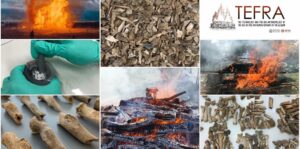Events Calendar – British School at Athens

- This event has passed.
BSA Supporter Exclusive Lecture
Dr Sevi Triantaphyllou (Aristotle University of Thessaloniki), “Investigating the use of fire on human remains in the prehistoric Aegean”
Abstract: Exposure of the body to fire causes various physical and chemical alterations which involve shrinkage, breakage, warping, complete deformation as well as removal of the organic component and the modification of the inorganic crystal component of the bones. Varying degrees of heat-induced effects predominate on human remains due to fire set up deliberately in direct contact to the human body and these are interpreted as the result of an elaborate and time-consuming procedure widely known as cremation. Similar effects are also evident when burning is applied on funerary contexts as an act of fumigation, practical cleansing of the human bones, or a symbolic practice. Regarding ancient Greece, burning of the human body has been identified almost exclusively with the practice of cremation which until a few years ago the latter was considered to represent a novel mode of disposal having occurred soon after the collapse of the Mycenaean palaces in the 13 th c. BC.
Current presentation aims to trace the evidence of firing the human remains throughout the prehistoric Aegean and reconsider the old-standing view of the ‘sudden’ emergence of the practice and its link with exogenous factors. Instead, particular emphasis will be given on the occurrence of cremation as early as in the Mesolithic and the Early Neolithic as well as on the variable intensity of exposure of the human remains in firing conditions throughout the Aegean prehistory. Methodological tools which have been applied involve: 1) published excavation data, 2) macroscopic as well as isotopic heat-induced alterations derived from selected sites with cremated remains from different regions of the Aegean, and 3) experimental research by simulating firing conditions of the past. The holistic approach and the interdisciplinary character of the research will bring together a great range of information and data and will shed new light on the use and the technology of cremation.
Bio: Sevi Triantaphyllou obtained her first degree in Archaeology (1990) and Mphil in Prehistoric Archaeology (1992) at the Aristotle University of Thessaloniki, Greece. She then completed her MSc in Osteology, Paleaopathology and Funerary Archaeology (1993) and PhD (2000) at the University of Sheffield, UK. She has a rich experience in excavating, documenting and studying skeletal material in the Greek mainland, Peloponnese, Crete and the Cyclades. In 2011 she was appointed as Lecturer in Prehistoric Archaeology and Osteoarchaeology at the School of History and Archaeology, Aristotle University of Thessaloniki promoted to Assistant Professor in 2014 and to Associate Professor in 2020. Since 2020 she is directing the University Thessaloniki Toumba excavation and she is also principal collaborator in the excavation, documentation and publication of the cemeteries at Kephala Petras in eastern Crete and Koumasa in central Crete. Currently she is the principal investigator of the research program TEFRA which is investigating the technology and the bioanthropology of the use of fire on human remains in the prehistoric Aegean and is funded by the Hellenic Foundation for Research and Innovation (H.F.R.I.).
Online only, 7pm (Greece) / 5pm (UK)
This is an exclusive event for BSA Supporters only. If you would like to join us, please consider signing up as a Supporter for as little as £50 per year (£20 for students) if you have not already done so. You can find out more, and sign up, here. Supporters in the Friends, Director’s Circle, Lamb Circle and Pendlebury Circle will automatically receive the webinar registration link via email the day before the lecture.
When: 5 March, 2024 @ 5:00 pm - 6:00 pm GMT
Where: Online only – –
